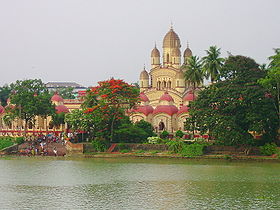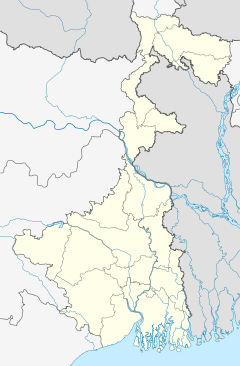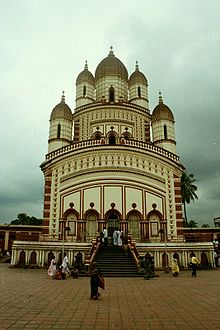- Dakshineswar Kali Temple
-
Dakshineswar Kali Temple 
Coordinates: 22°39′18″N 88°21′28″E / 22.655°N 88.35778°ECoordinates: 22°39′18″N 88°21′28″E / 22.655°N 88.35778°E Name Proper name: Dakshineswar Kali Temple Location Country: India State: West Bengal Location: Kolkata Architecture and culture Primary deity: Bhavatarini Kali Architectural styles: Bengal architecture History Date built:
(Current structure)1855 Creator: Rani Rashmoni The Dakshineswar Kali Temple (Bengali: দক্ষিনেশ্বর কালী মন্দির Dokkhineshshôr Kali Mondir, Sanskrit: दक्षिनेश्वर काली मन्दिर) is a Hindu temple located in Dakshineswar near Kolkata. Situated on the eastern bank of the Hooghly River, the presiding deity of the temple is Bhavatarini, an aspect of Kali, meaning, 'She who liberates Her devotees from the ocean of existence i.e Saṃsāra'.[1] The temple was built by Rani Rashmoni, a philanthropist and a devotee of Kali in 1855. The temple is famous for its association with Ramakrishna a mystic of 19th Century Bengal.
The temple compound, apart from the nine-spired main temple, contains a large courtyard surrounding the temple, with rooms along the boundary walls. There are twelve shrines dedicated to Shiva—Kali's companion—along the riverfront, a temple to Radha-Krishna, a bathing ghat on the river, a shrine dedicated to Rani Rashmoni. The chamber in the northwestern corner just beyond the last of the Shiva temples, is where Ramakrishna spent a considerable part of his life.
Contents
History
 Ramakrishna came to the temple in 1855, as an assistant to his elder brother, Ramkumar, the head priest, a job he took over the next year, after Ramkumar's death
Ramakrishna came to the temple in 1855, as an assistant to his elder brother, Ramkumar, the head priest, a job he took over the next year, after Ramkumar's death
The Dakshineswar Kali Temple was founded around the middle of the 19th Century by Rani Rashmoni.[2] Rani Rashmoni belonged to Kaivarta caste[3] and was well known for her philanthropic activities. In the year 1847, Rashmoni, prepared to go upon a long pilgrimage to the sacred Hindu city of Kashi to express her devotions to the Divine Mother. Rani was to travel in twenty four boats, carrying relatives, servants and supplies. According to traditional accounts, the night before the pilgrimage began, Rashmoni had a vision of the Divine Mother, in the form of the goddess Kali in a dream and reportedly said,[4]
“ There is no need to go to Banaras. Install my statue in a beautiful temple on the banks of the Ganges river and arrange for my worship there. Then I shall manifest myself in the image and accept worship at that place. ” Profoundly affected by the dream, Rani immediately looked for and purchased land, and promptly began construction of the temple. The large temple complex was built between 1847 and 1855. The 20-acre (81,000 m2) plot was bought from an Englishman, John Hastie and was then popularly known as Saheban Bagicha, [5] partly old Muslim burial ground shaped like a tortoise, considered befitting for the worship of Shakti according to Tantra traditions, it took eight years and nine hundred thousand rupees to complete the construction, and finally the idol of Goddess Kali was installed 31st May 1855, amid festivities at the temple formally known as Sri Sri Jagadishwari Mahakali, with Ramkumar Chhattopadhyay as the head priest; soon his younger brother Gadai or Gadadhar (later known as Ramakrishna) moved in and so did nephew Hriday to assist him.[1]
The next year, Ramkumar Chhattopadhyay died, the position was given to Ramakrishna, along with his wife Sarada Devi, who stayed in the south side of the Nahabat (music room), in a small room on the ground floor, which now a shrine dedicated to her.
From then until his death 30 years later in 1886, Ramakrishna was responsible for bringing much in the way of both fame and pilgrims to the temple.[6]
Architecture
Built in the traditional 'Nava-ratna' or nine spires style of Bengal architecture, the three-storeyed south-facing temple has nine spires distributed in upper two storeys, and stands on a high platform with a flight of stairs, over all it measures 46 feet (14 m) square and rises over 100 feet (30 m) high.
The garbha griha (sanctum sanctorum) houses an idol of goddess Kali idol, known as Bhavataraini, standing on the chest of a lying Shiva, and the two idols are placed on a thousand-petaled lotus made of silver.
Close to the main temple are the row of twelve identical Shiva temples built facing the east in the typical ‘Aat Chala’ Bengal architecture, they are built on either side of the ghat on the Hoogly river. To the North east of the Temple Complex is the Vishnu Temple or the Radha Kanta’s Temple. A flight of steps lead to the columned verandah and into the temple where a silver throne rests with a 21 and half inches idol of Lord Krishna and 16 inches (410 mm) idol of Radha.
Gallery
-
Shrine dedicated to Rani Rashmoni
-
The south side of the Nahabat, where Sarada Devi lived in a small room on the ground floor
Further reading
See also
Notes
- ^ a b Mehrotra 2008 p.11
- ^ Harding 1998, p.xii
- ^ Sen, Amiya P. (June 2006). "Sri Ramakrishna, the Kathamrita and the Calcutta middle classes: an old problematic revisited". Postcolonial Studies 9 (2): 165–177. doi:10.1080/13688790600657835.
- ^ Rosen, Steven (2006). Essential Hinduism. Greenwood Publishing Group. pp. 201–202. ISBN 9780275990060. http://books.google.com/?id=WuVG8PxKq_0C&pg=PA201.
- ^ Prabhananda 2003
- ^ Balakrishnan, S (May 09, 2003). "Kali Mandir of Kolkata". The Hindu. http://www.hindu.com/thehindu/fr/2003/05/09/stories/2003050901460700.htm. Retrieved 2009-11-10.
References
- Dutta, Krishna (2003). Calcutta: a cultural and literary history (illustrated ed.). Signal Books. pp. 255. ISBN 9781902669595. http://books.google.com/?id=UKfoHi5412UC&printsec=frontcover
- Prabhananda, Swami (October 2003). "The Kali Temple at Dakshineswar and Sri Ramakrishna". Vedanta Kesari. http://www.eng.vedanta.ru/library/vedanta_kesari/Kali_temple_and_Ramakrishna_oct_03.php.
- "Map of Kali Temple at Dakshineshwar". Archived from the original on 2008-06-12. http://web.archive.org/web/20080612044541/http://www.rkmpune.org/rk_order/dakshineshwar.htm. Retrieved 2008-11-05.
- Harding, Elizabeth U. (1998). Kali: The Black Goddess of Dakshineswar. Motilal Banarsidass. ISBN 8120814509. http://books.google.com/?id=4woiJbQTsBQC
- Mehrotra, Rajiv (2008). Thakur: A Life Of Sri Ramakrishna. Penguin Books India. ISBN 0143063715
External links
- Dakshineswar Kali Temple, website
- Dakshineswar travel guide from Wikitravel
- Dakshineswar.com - gives details about the origin and history of the temple
- Pilgrim shrine connected with Sri Ramakrishna
- Belur Math to Dakshineshwar Pilgrimage ( Video )
- Dakshineshwar Map with photos
North 24 Parganas district topics General Bibhutibhushan Wildlife Sanctuary • Dakshineswar Kali Temple • Gangaridai • Kanchrapara Airfield · Marichjhanpi · Sundarbans • Sundarban National Park • West Bengal State University • Kripamayee Kali TempleSubdivisions Bangaon • Barrackpore • Barasat Sadar • Basirhat • BidhannagarLocations
other than cities and townsMunicipalities Ashoknagar Kalyangarh • Baduria • Baranagar • Barasat • Barrackpore • Basirhat • Bhatpara • Bidhannagar • Garulia • Gobardanga • Habra • Halisahar • Kamarhati • Kanchrapara • Khardaha • Madhyamgram • Naihati • North Barrackpur • North Dumdum • Panihati • Rajarhat • South Dumdum • Taki • TitagarhCommunity development blocks Barasat Sadar subdivision Amdanga • Deganga • Barasat I • Barasat II • Habra I • Habra II • Rajarhat Basirhat subdivision Baduria • Basirhat I • Basirhat II • Haroa • Hasnabad • Hingalganj • Minakhan • Sandeshkhali I • Sandeshkhali II • Swarupnagar Bangaon subdivision Bagdah • Bangaon • Gaighata Barrackpore subdivision Barrackpore I • Barrackpore IIRivers Transport NH 34 • NH 35 • Belghoria Expressway • Jubilee Bridge • Vivekananda Setu • Nivedita Setu • Netaji Subhash Chandra Bose International Airport • Barasat Basirhat Railway • Eastern Railway • Kolkata Suburban Railway • List of bus routes in KolkataLok Sabha constituencies Bangaon • Barrackpore • Barasat • Basirhat • Dum DumVidhan Sabha constituencies Bagda • Bangaon Uttar • Bangaon Dakshin • Gaighata • Swarupnagar • Baduria • Habra • Ashoknagar • Amdanga • Bijpur • Naihati • Bhatpara • Jagatdal • Noapara • Barrackpore • Khardaha • Dum Dum Uttar • Panihati • Kamarhati • Baranagar • Dum Dum • Rajarhat New Town • Bidhannagar • Rajarhat Gopalpur • Madhyamgram • Barasat • Deganga • Haroa • Minakhan • Sandeshkhali • Basirhat Dakshin • Basirhat Uttar • HingalganjFormer Vidhan Sabha constituencies Titagarh • HasnabadSee also Cities and towns in North 24 Parganas district • People from North 24 Parganas districtOther districts in West Bengal Bankura • Bardhaman • Birbhum • Cooch Behar • Dakshin Dinajpur • Darjeeling • Hooghly • Howrah • Jalpaiguri • Kolkata • Malda • Murshidabad • Nadia • Paschim Medinipur • Purba Medinipur • Purulia • South 24 Parganas • Uttar DinajpurSurrounding areas outside West Bengal Bangladesh Khulna DivisionTemples in West Bengal Temples Ananta Basudeba · Bahulara Siddheshwara · Belur Math · Dakshineswar · Kalighat · Kalyaneshwari · HangseshwariCentres Antpur · Bakreshwar · Barakar · Bansberia · Bishnupur · Dharapat · Ekteswar · Gangasagar · Jaydev Kenduli · Kalna · Kamarpukur · Kankalitala · Labhpur · Mainaguri · Makardaha · Mayapur · Rajbalhat • Sonatapal · Tarapith · TarakeswarHindu Temples in West Bengal Bardhaman Kalyaneshwari Temple • Khaepa Kali Tala
Birbhum Hooghly Howrah Jalpaiguri Kolkata Nadia North 24 Parganas Dakshineswar Kali Temple • Kripamayee Kali Temple
Categories:- Hindu temples in West Bengal
- Buildings and structures in Kolkata
- Visitor attractions in Kolkata
- Shakti temples
- Shaktism
- Ramakrishna
- Religious organizations established in 1855
Wikimedia Foundation. 2010.










